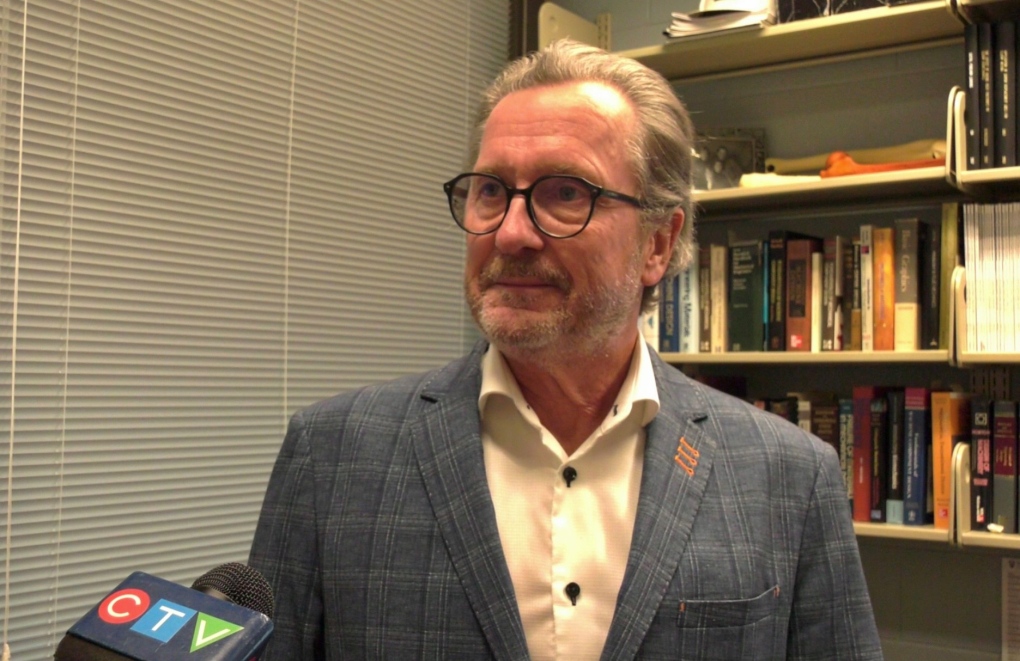Two Western U researchers receive grants to find solutions for arthritis
Arthritis Society Canada is trying to uncover more solutions to arthritis disease which is currently affecting six million Canadians, according to Dr. Sian Bevan.
The national charity has announced two researchers from Western University have been awarded grants to further research how to prevent and treat this disease.
“With these awards, we are investing in rising research stars and novel solutions to get ahead of arthritis and push for a future that is pain-free,” said Bevan, who is the chief science officer with Arthritis Society Canada.
“We know that arthritis is a very significant problem in Canada. Arthritis is actually the leading cause of disability and chronic illness in the country so we need to do something,” she said.
Dr. Matthew Teeter is one of the eight recipients. He is a professor in medical biophysics, medical imaging and surgery at the Schulich School of Medicine & Dentistry. He is also a scientist at Robarts Research Institute and Lawson Health Research Institute.
Teeter said one of his goals is to improve patient’s quality of life after joint replacement.
One of his projects will look at the factors that affect bone and growth around implants to make sure they are going to last a long time.
 Dr. Matthew Teeter, an associate professor at Western University is one of the eight recipients who received a research grant from Arthritis Society Canada. (Source: Teeter Lab)
Dr. Matthew Teeter, an associate professor at Western University is one of the eight recipients who received a research grant from Arthritis Society Canada. (Source: Teeter Lab)
“With these research dollars we can actually make sure that people undergoing joint replacement are going to get the best possible outcome,” he said. “To make sure that if they've waited long enough and they finally get the surgery they know they’re going to have a long-lasting joint replacement which is going to give them their life back.”
The other project he is working on also looks at the outcome of patients’ surgeries following joint replacement.
“Many patients are unhappy after the surgery and we want to find out if it’s because they have an inappropriate expectation going into the surgery or whether there are some ongoing issues within the joint which is causing them to be unhappy,” said Teeter.
Teeter’s goal is to “enhance patient mobility and quality of life after joint replacement through the development and application of imaging and digital technologies.”
Understanding what puts patients at risk and how they can be treated can help them receive a more personalized treatment, which Teeter hopes will avoid any complications for the patient.
Dr. Jim Johnson is also one of the eight recipients. He’s a professor of mechanical and materials engineering at Western University and is one of the directors of the bioengineering research laboratory at Lawson.
Johnson also works as the director of the Hand and Upper Limb Clinic at St. Josephs Health Care.
 Dr. Jim Johnson, a professor at Western University said he and his graduate students will be looking for new designs for partial implants in hopes the study could lead to a new type of joint replacement. (Jenn Basa/CTV News London)
Dr. Jim Johnson, a professor at Western University said he and his graduate students will be looking for new designs for partial implants in hopes the study could lead to a new type of joint replacement. (Jenn Basa/CTV News London)
He told CTV News London that he and his graduate students would be looking for new designs for partial implants in hopes the study could lead to a new type of joint replacement that would be less invasive and a faster recovery for patients.
“I have been fortunate enough to attract really strong graduate students so it will primarily be given to them,” said Johnson.
“They will both conduct experimental studies where they will look at how these new designs, which they will design actually, perform and will also do computer-based computational models,” he explained.
Since there are no age restrictions when it comes to arthritis, Johnson said one of the advantages of the devices they are interested in is that they are smaller and less invasive, meaning younger patients can benefit from this new implant.
“Younger patients, even 50 is young for a patient these days. You’re not replacing a lot of bone just a little bit, and hence giving them those extra years they need, maybe to move onto a total joint replacement at this point,” he said.
A common misconception is that the disease only affects older people, said Bevan. However, teens and children can also be susceptible to arthritis. “One in five Canadians has arthritis and by 2040 it will rise to one in four.” She added.
There are over 100 different types of arthritis, according to Bevan. She said finding treatments for each one is one of their goals.
The Arthritis Society, which has branches across Canada, is vital in helping people deal with the disease at all ages, providing programs, support and information through a variety of means including phone lines and an extensive website.
CTVNews.ca Top Stories

opinion Tom Mulcair: Prime Minister Justin Trudeau's train wreck of a final act
In his latest column for CTVNews.ca, former NDP leader and political analyst Tom Mulcair puts a spotlight on the 'spectacular failure' of Prime Minister Justin Trudeau's final act on the political stage.
B.C. mayor gets calls from across Canada about 'crazy' plan to recruit doctors
A British Columbia community's "out-of-the-box" plan to ease its family doctor shortage by hiring physicians as city employees is sparking interest from across Canada, says Colwood Mayor Doug Kobayashi.
'There’s no support': Domestic abuse survivor shares difficulties leaving her relationship
An Edmonton woman who tried to flee an abusive relationship ended up back where she started in part due to a lack of shelter space.
Baseball Hall of Famer Rickey Henderson dead at 65, reports say
Rickey Henderson, a Baseball Hall of Famer and Major League Baseball’s all-time stolen bases leader, is dead at 65, according to multiple reports.
Arizona third-grader saves choking friend
An Arizona third-grader is being recognized by his local fire department after saving a friend from choking.
Germans mourn the 5 killed and 200 injured in the apparent attack on a Christmas market
Germans on Saturday mourned the victims of an apparent attack in which authorities say a doctor drove into a busy outdoor Christmas market, killing five people, injuring 200 others and shaking the public’s sense of security at what would otherwise be a time of joy.
Blake Lively accuses 'It Ends With Us' director Justin Baldoni of harassment and smear campaign
Blake Lively has accused her 'It Ends With Us' director and co-star Justin Baldoni of sexual harassment on the set of the movie and a subsequent effort to “destroy' her reputation in a legal complaint.
Oysters distributed in B.C., Alberta, Ontario recalled for norovirus contamination
The Canadian Food Inspection Agency has issued a recall due to possible norovirus contamination of certain oysters distributed in British Columbia, Alberta and Ontario.
New rules clarify when travellers are compensated for flight disruptions
The federal government is proposing new rules surrounding airlines' obligations to travellers whose flights are disrupted, even when delays or cancellations are caused by an "exceptional circumstance" outside of carriers' control.


































